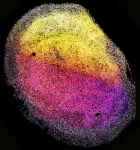(Press-News.org) Sleep is a fundamental need, just like food or water. “You’ll die without it,” said Keith Hengen, an assistant professor of biology at Washington University in St. Louis. But what does sleep actually accomplish? For years, the best researchers could say is that sleep reduces sleepiness — hardly a satisfying explanation for a basic requirement of life.
But by melding concepts from the fields of physics and biology, Hengen and a team of Arts & Sciences researchers have constructed a theory that could explain both the meaning of sleep and the complexity of the brain. As reported in a new study published in Nature Neuroscience, they tracked the brain activity of sleeping rats to make the case that the brain needs to regularly reset its operating system to reach “criticality,” a state that optimizes thinking and processing.
“The brain is like a biological computer,” Hengen said. “Memory and experience during waking change the code bit by bit, slowly pulling the larger system away from an ideal state. The central purpose of sleep is to restore an optimal computational state.”
Co-authors of the paper include Ralf Wessel, a professor of physics; Yifan Xu, a graduate student in biology studying neuroscience; and Aidan Schneider, a graduate student in the Computational & Systems Biology program, all in Arts & Sciences.
Wessel said physicists have been thinking about criticality for more than 30 years, but they never dreamed the work would have implications for sleep. In the world of physics, criticality describes a complex system that exists at the tipping point between order and chaos. “At one extreme, everything is completely regular. At the other extreme, everything is random,” Wessel said.
Criticality maximizes the encoding and processing of information, making it an attractive candidate for a general principle of neurobiology. In a 2019 study, Hengen and Wessel established that the brain actively works to maintain criticality.
In the new paper, the team provides the first direct evidence that sleep restores the computational power of the brain. It’s a radical departure from the long-held assumption that sleep must somehow replenish mysterious and unknown chemicals depleted during waking hours.
After their 2019 paper, Hengen and Wessel theorized that learning, thinking and being awake must push the brain away from criticality and that sleep is perfectly positioned to reset the system. “We realized this would be a really cool and intuitive explanation for the core purpose of sleep,” Hengen said. “Sleep is a systems-level solution to a systems-level problem.”
Brain cascades
To test their theory on the role of criticality in sleep, the researchers tracked the spiking of many neurons in the brains of young rats as they went about their normal sleeping and waking routines. “You can follow these little cascades of activity through the neural network,” Hengen said. These cascades, also called neural avalanches, reflect how information flows through the brain, he said. “At criticality, avalanches of all sizes and durations can occur. Away from criticality, the system becomes biased toward only small avalanches or only large avalanches. This is analogous to writing a book and only being able to use short or long words.”
As predicted, avalanches of all sizes occurred in the rats that had just woken up from restorative sleep. Across the course of waking, the cascades started to shift toward smaller and smaller sizes. The researchers found they could predict when rats were about to go to sleep or wake up by tracking the distribution of avalanches. When cascade sizes were reduced to a certain point, sleep wasn’t far away.
“The results suggest that every waking moment pushes relevant brain circuits away from criticality, and sleep helps the brain reset,” Hengen said.
Physics meets biology
When physicists first developed the concept of criticality in the late 1980s, they were looking at piles of sand on a checkerboard-like grid, a scenario seemingly far removed from brains. But those sand piles provided an important insight, Wessel said. If thousands of grains are dropped on the grid following simple rules, the piles quickly reach a critical state where interesting things start happening. Avalanches both large and small can start without warning, and piles in one square start spilling into the others. “The whole system organizes itself into something extremely complex,” he said.
The neural avalanches taking place in the brain are much like the avalanches of sand on a grid, Wessel said. In each case, the cascades are the hallmark of a system that has reached its most complex state.
According to Hengen, every neuron is like an individual grain of sand following very basic rules. Neurons are essentially on/off switches that decide whether or not to fire based on straightforward inputs. If billions of neurons can reach criticality — the sweet spot between too much order and too much chaos — they can work together to form something complex and wondrous. “Criticality maximizes a bunch of features that sound very desirable for a brain,” Hengen said.
The new study was a multidisciplinary effort. Hengen, Xu and Schneider designed the experiments and provided the data, while Wessel joined the team to implement the mathematical equations necessary to understand sleep in the framework of criticality. “It’s a beautiful collaboration between physics and biology,” Wessel said.
END
Why do we sleep? Researchers propose an answer to this age-old question
2024-01-08
ELSE PRESS RELEASES FROM THIS DATE:
Singh studying distributed computing models and algorithms for pervasive systems
2024-01-08
Gurdip Singh, Divisional Dean, School of Computing, received funding from the National Science Foundation for the project: "EAGER: Distributed Computing Models and Algorithms for Pervasive Systems."
The goal of this project is to extend the traditional graph-based distributed computing models and algorithms to develop a unified model to study cyber-physical systems. The unified models will capture interactions between the physical and cyber entities and the physical phenomena. This project also proposes to develop techniques to design distributed algorithms for fundamental problems ...
Narayanan developing treatments for alphaviruses
2024-01-08
Aarthi Narayanan, Professor, Biology, received funding for the project: "Further the development of Omaveloxolone and Bardoxolone methyl as broadly effective countermeasures against alphaviruses to Support the Battelle Accelerated Therapeutics for Combating Acute Viral Epidemics (BAT-CAVE) Program."
The principal purpose of this program is to conduct Research and Development into medical, pharmaceutical, and diagnostic technologies to enhance mission effectiveness of military personnel, collaborating ...
SwRI awarded $54 million contract to develop QuickSounder weather satellite
2024-01-08
SAN ANTONIO — January 8, 2024 —NASA and NOAA have selected Southwest Research Institute (SwRI) to develop QuickSounder, the first in a new generation of NOAA low-Earth orbit environmental satellites. Under the $54 million contract, SwRI will design and build the satellite and operate it for three years.
QuickSounder will kick off NOAA’s Near Earth Orbit Network (NEON) program. The Near Earth Orbit Network is a collaborative mission between NASA and NOAA. NASA will manage the development and launch of the satellites for NOAA, which will operate them and deliver data to users worldwide. NEON satellites ...
Novel tissue-derived brain organoids could revolutionize brain research
2024-01-08
Press release – Princess Máxima Center for pediatric oncology
EMBARGO: 8 JANUARY 2024 AT 11:00 AM ET (US)
Scientists have developed 3D mini-organs from human fetal brain tissue that self-organize in vitro. These lab-grown organoids open up a brand-new way of studying how the brain develops. They also offer a valuable means to study the development and treatment of diseases related to brain development, including brain tumors.
Scientists use different ways to model the biology of healthy tissue and disease in the lab. These include cell lines, laboratory animals and, since a few years, 3D mini-organs. ...
SARS-CoV-2 BA.2.86 is less resistant to vaccine, but may be a problem in the lung
2024-01-08
COLUMBUS, Ohio – New research shows that the recently emerged BA.2.86 omicron subvariant of the virus that causes COVID-19 can be neutralized by bivalent mRNA vaccine-induced antibodies in the blood, which explains why this variant did not cause a widespread surge as previously feared.
However, the study in cell cultures showed this SARS-CoV-2 variant can infect human cells that line the lower lung and engage in virus-host cell membrane fusion more efficiently, two features linked to severe disease symptoms.
The study is published today (Jan. 8, 2024) in the journal Cell.
The BA.2.86 variant of omicron is the ancestor of the currently dominating JN.1 and has about ...
Sibling death in childhood and early adulthood and risk of early-onset cardiovascular disease
2024-01-08
About The Study: In this study of more than 2 million individuals born in Denmark, sibling death in childhood and early adulthood was associated with increased risks of overall and most type-specific early-onset cardiovascular diseases, with the strength of associations varying by cause of death and age difference between sibling pairs. The findings highlight the need for extra attention and support to the bereaved siblings to reduce cardiovascular disease risk later in life.
Authors: Guoyou Qin, Ph.D., and Yongfu Yu, Ph.D., ...
Early-life digital media experiences and development of atypical sensory processing
2024-01-08
About The Study: Early-life digital media exposure was associated with atypical sensory processing outcomes in multiple domains in this study that included 1,471 children. These findings suggest that digital media exposure might be a potential risk factor for the development of atypical sensory profiles. Further research is needed to understand the relationship between screen time and specific sensory-related developmental and behavioral outcomes, and whether minimizing early-life exposure can improve subsequent sensory-related outcomes.
Authors: Karen F. Heffler, M.D., of the Drexel University ...
Diagnostic errors in hospitalized adults who died or were transferred to intensive care
2024-01-08
About The Study: Diagnostic errors in hospitalized adults who died or were transferred to the intensive care unit were common and associated with patient harm in this analysis of 2,428 patient records at 29 hospitals. Problems with choosing and interpreting tests and the processes involved with clinician assessment are high-priority areas for improvement efforts.
Authors: Andrew D. Auerbach, M.D., M.P.H., of the University of California, San Francisco, is the corresponding author.
To access the embargoed study: Visit ...
Putting your toddler in front of the TV? You might hurt their ability to process the world around them, new data suggests
2024-01-08
Babies and toddlers exposed to television or video viewing may be more likely to exhibit atypical sensory behaviors, such as being disengaged and disinterested in activities, seeking more intense stimulation in an environment, or being overwhelmed by sensations like loud sounds or bright lights, according to data from researchers at Drexel’s College of Medicine published today in the journal JAMA Pediatrics.
According to the researchers, children exposed to greater TV viewing by their second birthday were more likely to develop atypical sensory processing behaviors, such as “sensation seeking” and “sensation ...
Closing in on triple-negative breast cancer
2024-01-08
Cedars-Sinai Cancer investigators have analyzed the cells within triple-negative breast cancer tumors before and after radiation therapy with immunotherapy, identifying three patient groups with different responses to the treatment. Their study, published in the peer-reviewed journal Cancer Cell, found that for some patients with this difficult-to-treat cancer, radiation therapy plus immunotherapy could yield the best tumor-fighting immune response prior to surgery.
“Our most important finding was identifying these three different patient groups,” said Simon Knott, PhD, co-director of the Applied Genomics Shared Resource at ...

